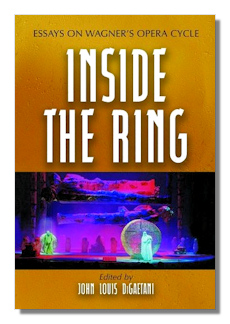
The Internet's Premier Classical Music Source
Related Links
-
Introduction
Acoustics
Ballet
Biographies
Chamber Music
Composers & Composition
Conducting
Criticism & Commentary
Discographies & CD Guides
Fiction
History
Humor
Illustrations & Photos
Instrumental
Lieder
Music Appreciation
Music Education
Music Industry
Music and the Mind
Opera
Orchestration
Reference Works
Scores
Thematic Indices
Theory & Analysis
Vocal Technique
Search Amazon
Recommended Links
Site News
 Book Review
Book Review
Inside…Outside The Ring

Inside The Ring
Essays on Wagner's Opera Cycle
Edited by John Louis DiGaetani
McFarland & Company, 2006. 252 pages
Softcover, alkaline paper. Illustrated.
ISBN-10: 0786423307
ISBN-13: 978-0786423309


Wagner Outside The Ring
Essays on the Operas, Their Performances and
Their Connections with Other Arts
Edited by John Louis DiGaetani
McFarland & Company. 2009. 262 pages
Softcover, alkaline paper. Illustrated.
ISBN-10: 0786434007
ISBN-13: 978-0786434008
DiGaetani, a Professor of English at Hofstra and longtime opera enthusiast, has written or edited about a dozen books on opera and drama, including five about Wagner. This pair of volumes, the most recent suggested by the publisher as a follow-up to the previous, includes 33 scholarly essays on many aspects of Wagner's ten major operas (a term DiGaetani prefers to "music dramas") by 20 accomplished writers, including a half dozen by the editor, and three each by Barbara Guenther and James K. Holman, the last named the author of Wagner's Ring: A Listener's Companion and Concordance and to whom the Inside volume is dedicated.
Inside The Ring begins with DiGaetani's introduction titled "The Cycles in the Cycle," returning to one of the main themes in his book Wagner and Suicide. One of his essays is on Wagnerian Opera's influence on world literature and another is about Wagner's self-exile in Switzerland. DiGaetani's final short essay at the end will surprise many readers with his claim that Wagner's operas were too short.
A multipart essay by Holman includes some biographical data, an account of Wagnerism after the composer's death and some production history; as well as a critique of Jacques Barzun's 1949 book, Darwin, Marx, Wagner; and remarks on the "Wagner Industry." Nicholas Vazsonyi explores the last-named in "Selling the Ring." A substantial and particularly interesting portion of the Ring book deals with Production and performance history of the Ring, particularly in Germany, before, during and after the Nazi period and explains concept productions (sometimes called Eurotrash) as a reaction against Nazi era productions. Steven Cerf's essay on the Ring and German culture is especially good. Brigitte Heldt focuses on the Ring's Munich premiere and Joann P. Krieg adds an account of The Ring in America.
Barbara J. Guenther's offers a scholarly essay on "Romanticism in the Ring." Gregory Kershner writes about "Eros, Marriage and Incest in Die Walküre." Stewart Spencer analyzes the language Wagner used in his librettos. Neil K. Friedman gives a political scientist's view of class and capital in each of the Ring operas. The editor also presents an interview with Jane Eaglen, "the Isolde and Brunnhilde of choice in most opera houses of the world" at present.
The music of the Ring is not the main focus in this collection, but Geoffrey S. Riggs has a substantial and helpful critical account of recordings and videos, as well as a bibliography of books, librettos and music.
Wagner Outside The Ring is at least as interesting as its companion volume, with ten essays on the individual operas (some dealing with more than one, and including Wagner's "Juvenilia"). Three essays make reference to dance (Tannhäuser and Diaghilev), film (musical and stylistic influences) and fiction (Cather). Essays on performance matters include DiGaetanis' interviews with Ben Heppner and Michelle DeYoung.
I was particularly impressed with a study of the musical characterization of Kundry and Parsifal in Wagner's final opera, by John J.H. Muller, who teaches music history at Juilliard. Kundry he calls Wagner's "most fascinating and complex figure." Muller writes about the musical motifs which introduce Kundry and Parsifal in strictly musical terms. Kundry's four different motifs are discussed, along with several different themes depicting Parsifal, in both musical and dramatic terms. I read this essay more than once. Incidentally, among the many fine photographs (from productions at Bayreuth, the Metropolitan Opera and elsewhere) in these two volumes, there are some of four very different Kundrys at the Met, suggesting the possibility of different interpretations of this character.
In "The Silver Age of Wagnerian Singing" (1950s, 60s and 70s – between the wars being the "golden age") Barbara Josephine Guenther writes about the opera careers of Hans Fischer-Dieskau, Karl Ridderbusch, Wolfgang Windgassen, Jon Vickers, Birgit Nilsson, Régine Crespin, Christa Ludwig and several others, with notes and an extensive bibliography.
In an appendix, there is a discography and videography of recommended performances.
Wagner enthusiasts particularly will find much of considerable interest in these volumes. They also have reference value.
Copyright © 2010, R. James Tobin


















